#precolonial Philippines
Text
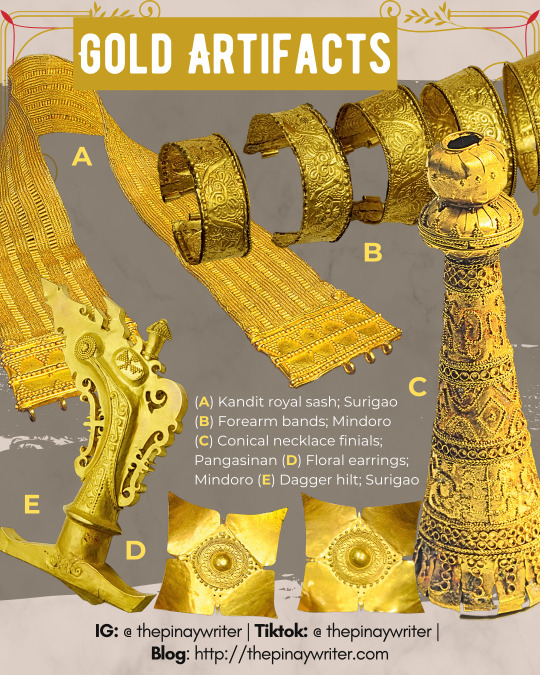

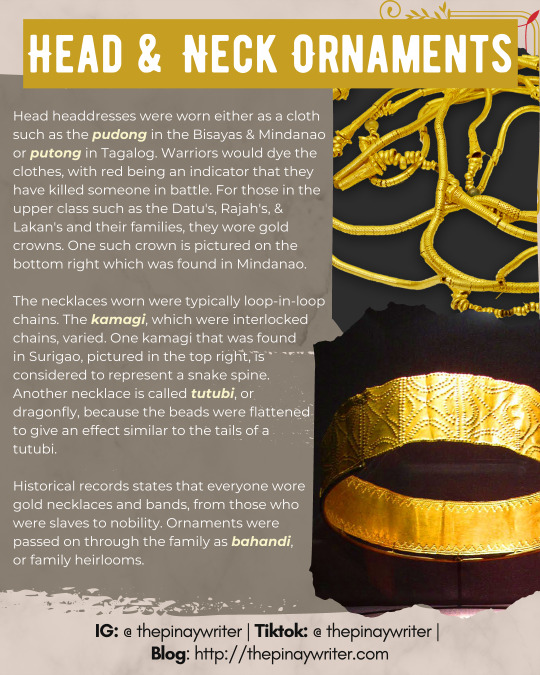
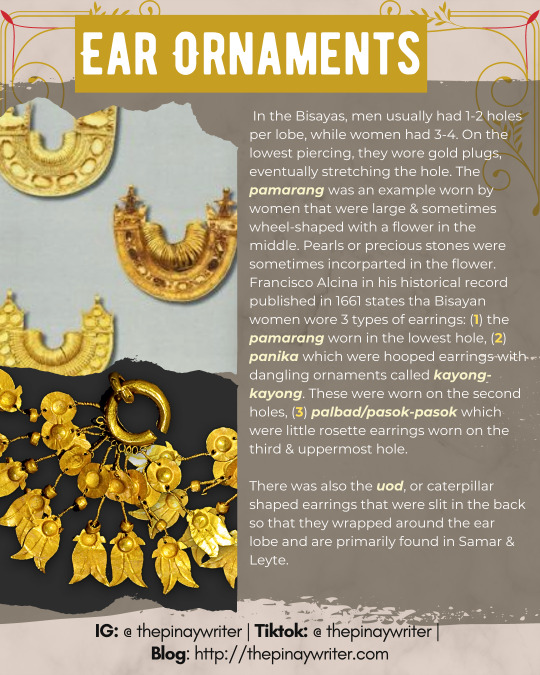

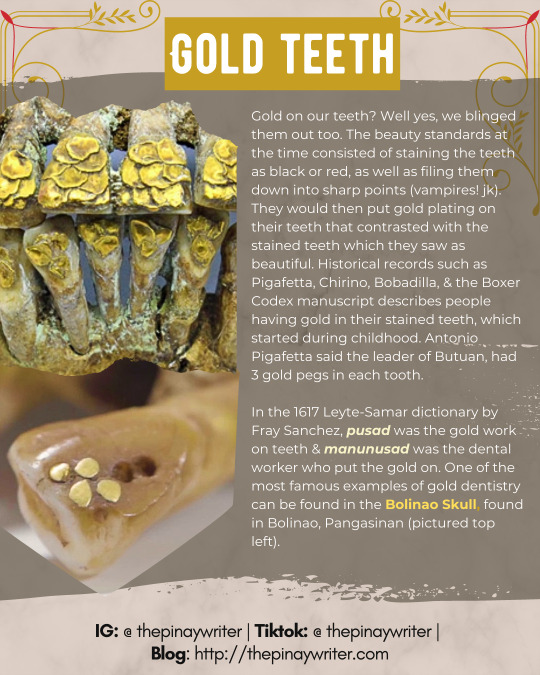


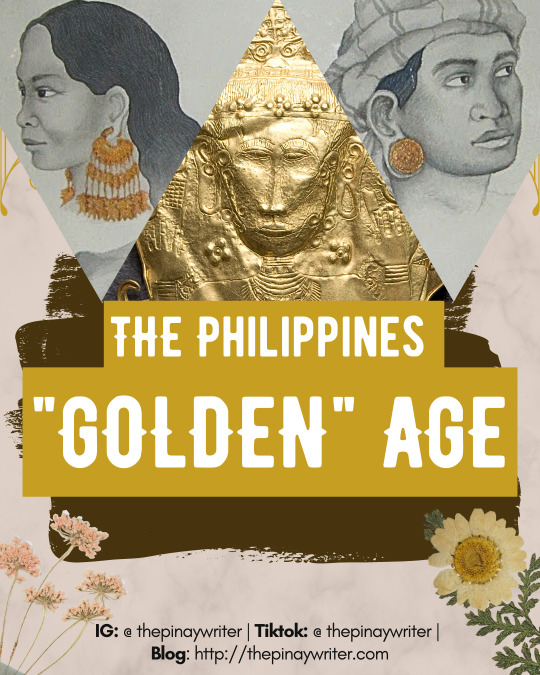
✨️ Our ancestors before the Spaniards arrived wore gold and passed them down through the generations, regardless of social class. They even crafted bowls, liquid vessels, and the hilts and covers of daggers and swords out of gold.
They buried these ornaments with the dead so that they could use it in the afterlife and as a token to give the spirit or deity to leave purgatory. They also covered the faces of the dead with gold death masks to protect them from evil spirits entering the body.
Numerous Spanish accounts record that they wore gold and buried their dead with gold bahandi, or heirlooms. From Antonio Pigafetta, Francisco Alcina, Pedro Chirino, Friar Bobadilla and within the Boxer Codex Manuscript. Together with historical accounts, archeological finds of gold artifacts from Luzon, the Bisayas, and Mindanao show how much our pre-colonial ancestors wore and used gold in their clothing, divine figures, and everyday wear, similar to the rest of Southeast Asia.
To see many of these artifacts, check out the gold exhibit in the National Museum of the Philippines and Ayala Museum.
#filipino#philippines#precolonial Philippines#gold#artifact#history#culture#filipino culture#pinoy#filipino mythology#archaeology
878 notes
·
View notes
Text


A couple of sketches from my novella, Metalmade. I meant to post this back in February for the 2nd-year anniversary of its launch, but I got sick and didn't have the energy to finish it until now.
It's about a sentient robot that gets tasked to spy on a taho-peddler to determine if he's actually an aswang in disguise, but despite her best efforts, she gets quite befuddled by him. That conversation they're having in the 2nd pic was so much fun to write.
Actually this whole novella was so much fun to write, and I have quite a few ideas for Yaya and Digan's adventures in Sagabilang, so a possible sequel is not off the table!
#ocs#original character#original work#filipino#precolonial philippines#fantasy#metalmade#my big orig#artph#digital art
69 notes
·
View notes
Text

#visayan#Filipino#lapu lapu#magellan#history#historical memes#colonizers#anti colonization#anti colonialism#pre colonial philippines#precolonial#precolonial Philippines#bisaya#bisayan
185 notes
·
View notes
Text

Hanan, goddess of the morning and dawn. In Tagalog mythology, she is Mayari and Tala's sister. She symbolizes the sign of a new day and age, and people pray to her at the break of dawn.
Tala, goddess of the stars. In Tagalog mythology, she is Mayari and Hanan's sister. She is famous for her help in creating the Tagalog constellations and is known to use divine spheres of light to guide sailors to safety at night. These spheres were soon feared as deadly beings of fire called "santelmos" due to Spanish influence.
#filipino mythology#rel'sart#hanan#tala#southeast asia#philippines#SEA#philippine mythology#anitu#anito#tagalog#kaluwalhatian#phart#in another myth Tala is the daughter of the Moon goddess#named Buan#but yeah anyways I am having brainrot lawl#precolonial philippines#in my hc Apolaki#Mayari#Tala#and Hanan are all siblings <333
290 notes
·
View notes
Text
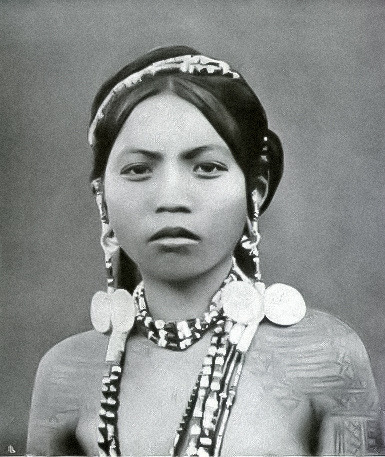



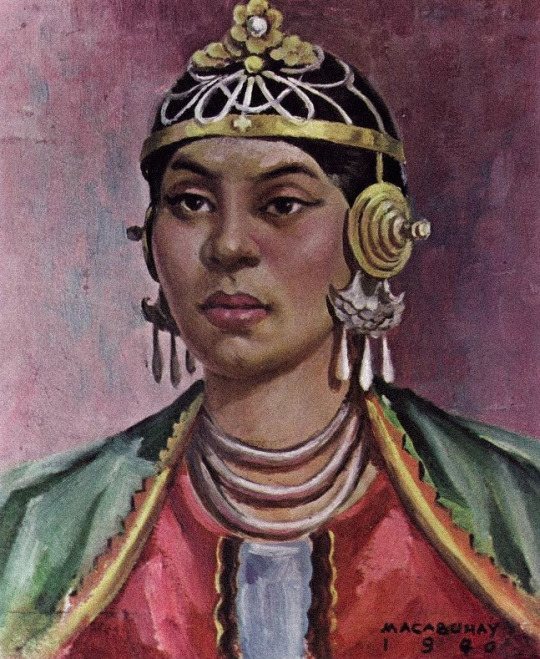
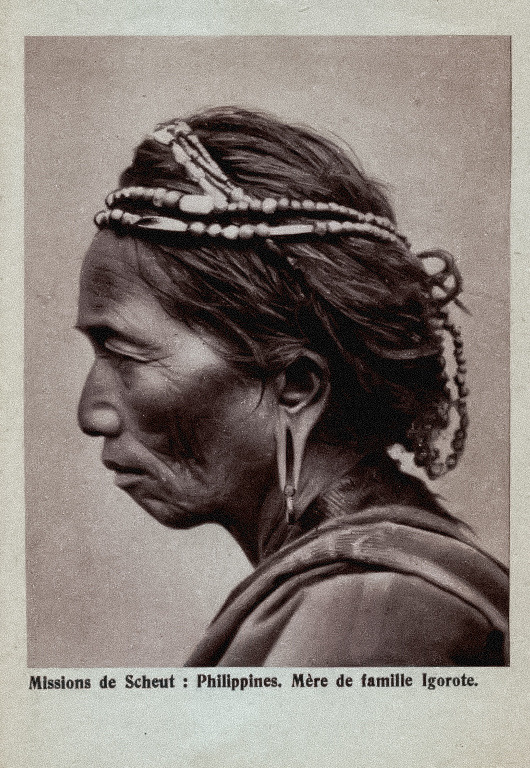
“It's in our blood to adorn ourselves with tattoos and embroidery, beads and gold.”
(Stephanie Gancayco, ‘Hella Pinay’ — 28/03/2017)
#venuscore#philippines#precolonial philippines#filipino culture#filipino#pinay#indigenous#tattoos#gold jewelry#painting#archeology#history#feminism#moodboard
11 notes
·
View notes
Text
Historical inspiration for my fantasy novel: Pre-colonial Philippines
Seeker of the Lost Song is a historically-inspired fantasy novel merging medieval Finnish & pre-colonial Filipino elements, and I wanted to share two elements of Filipino history I included.
☼ 1) Dulang, a low table ☼
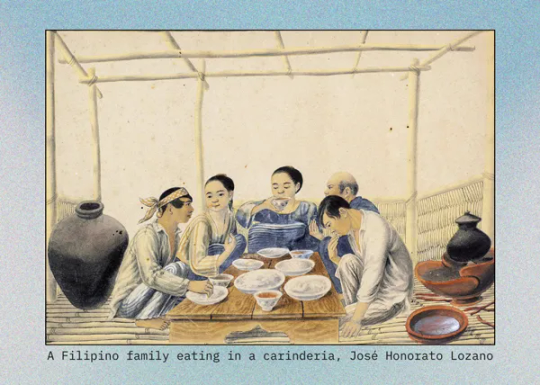
One of my favourite tidbits from my research is that pre-colonial Filipinos ate at a low table, sitting on the floor. Part of me worries that readers will think “Hey you stole that from Japan!” but I’m excited for the chance to show my people at their own low table, eating rice with their hands.
☼ 2) The balangay boat ☼

Another pre-colonial Filipino element I included in the book was a balangay, an ancient Filipino boat that’s recently come back into the public consciousness, with ancient boats being excavated and working replicas made. A quote from this article in STARweek, from one of the people who worked to rebuild the balangay, really resonated with me:
“It is very sad because we are a maritime people. We should be gifted and natural in the waters but colonialization robbed us of that consciousness. I am doing this to help rekindle that spirit”
The balangay that appears in my novel has a double outrigger (something that always feels so Filipino to me), but essentially it’s a larger version of the sketch pictured. And I have to admit, the scenes on the balangay did stir something in me. Something ancient and ancestral, perhaps?
Seeker’s as-yet-unnamed sequel also features elements of pre-colonial Filipino history, but more on that at another time. Suffice it to say I’m enjoying this opportunity to learn more about the history of my people and use it in a fantasy setting!
#amwriting#fantasy novel#seeker of the lost song#filipino history#canadian author#asian authors#southeast asia#precolonial philippines#asian fantasy#filipino fantasy
7 notes
·
View notes
Text
In 11th, century BC. My Precolonial Filipino ancestors discovers A giant reptilian monster who collapse and dies in Philippines :

#kong vs godzilla#godzilla x kong the new empire#Godzilla#That Godzilla specimen was Dagon#Precolonial#Precolonial Philippines
14 notes
·
View notes
Note
Do you know anything about pre-colonial ilokano culture? Like any practices, myths etc :)
Precolonial Ilokano culture has also been on my radar especially since I myself am of Ilokano descent actually! My ties to the culture had been severed by my Ilokano grandfather after a falling out with his family, but I might be able to get together some sources and articles on precolonial Ilocos some other time.
One of the most popular myths from the Ilokos region that is often taught in schools even outside the area is the Life of Lam-Ang or Biag ni Lam-Ang. This story follows Lam-Ang and different parts of his life from before his birth and up to his peaceful life after all of his adventures. You can read it here alongside a collection of other epics from other Filipino ethnic groups and an English translation here (thanks to a Christian school's English class lol)
From quick research, an article by Jordan Clark of the Aswang Project lists the 1978 book Handbook of Philippine Language Groups as source for knowing the early Ilokano pantheon or at least the generally accepted Ilokano pantheon.
This book identifies Buni as the supreme being of the pantheon, who, from other sources I've seen, is often referenced as someone who has tasked the giants with creation. I can't seem to find the specific myth that exactly references how the world had come to be. Parsua was also identified as a creation deity.
Then there are the deities related to different nature-related and weather-related things which are listed as Apo Langit (Lord Heaven), Apo Angin (Lord Wind), Apo Init (Lord Sun), and Apo Tudo (Lord Rain).
There are also variations listed within the article that had been referenced to have come from the book published in 1952 called the Historical and Cultural Data of Provinces specifically from Vigan, Ilocos Sur, although it seems to have more outsider influence.
Here's the plain-text from the article since it's pretty difficult to find other sources of this myth other than the book and the article:
Cabalangegan was formerly a jungle at the edge of the river Abra. On the far side of the river were mountains high and steep. On these mountains lived an old man named Abra, the father of Caburayan. The old man lived and controlled the weather. It is said that the river Abra was a gathering of water vapor, shaded, and the days were always bright with sunlight.
At that time Anianihan, God of Harvests, was in love with Anianihan, Goddess of Healing. Her mother, Lady Makiling knew about their mutual understanding, but Abra did not know it for the three were afraid to tell him since he might punish them as he disapproved of Anianihan. Abra wanted his daughter to marry either Saguday, God of the Wind, or Revenador, God of Thunder and Lightning. This being so, Anianihan took Caburayan from her home. Abra wept a great deal. He sent Lady Makiling away after beating her.
When Abra was alone, he wept day and night till Bulan, God of Peace and Calm, came. But though Bulan was there to brighten Abra’s spirits, Abra did not stop weeping. He could not express his anger. He begged the other gods to bring back his daughter.
One day the sun, eye of Amman, shone so bright that the water of the river Abra was excessively heated. Smoke rose from the river. Soon, thick, black clouds began to darken the sky. Then Saguday sent the strongest wind until the crowns of the trees brushed the ground. The god Revenador sent down the largest strings of fire. The heaviest of rains fell. All these frightful events lasted seven days. The river Abra then rose and covered the trees. There rose a vast body of water and the highest part of the mountain could be seen. It looked like the back of a turtle from a distance. At this spot Abra lived.
On the seventh day, Abra heard a cry. He also heard a most sorrowful song. Abra dried his tears and looked around, but he saw no one. He determined to find Maria Makiling, his grandchild. He did not find her for the cries of the baby had stopped.
The search for the baby lasted three full moons, but to no avail and the poor old man returned to his home very sad. He lost all hope. His wits were gone. At that time Maria Makiling was under the care of the fierce dog Lobo, that was under a god of the Underworld. He had been punished by the other gods and that is why he looked like a fierce dog. He was sent down to do charity.
From just the story alone, there's some obvious influences from other cultures such as one of the deities mentioned, Lady Makiling, the mother of Caburayan, having come from Laguna, as well as the usage of the word Lobo to name a fierce dog with the word having come from Spanish.
This may be the reason why this myth isn't regarded as highly as a more authentic version of the precolonial Ilocano pantheon although it is an interesting story still.
I do want to learn more about Ilocano precolonial culture too but that's all I have for now! Hopefully it's informative enough especially since finding sources outside the Aswang Project website is rather difficult.
#mayaqna#mayapino#runin-reads#ilocos#ilocano culture#ilocano mythology#philippines#filipino culture#filipino mythology#precolonial philippines#long post
18 notes
·
View notes
Text

Datu Portrait Practice
#portrait practice#digital painting#characterart#characterdesign#character design#datu#precolonial#precolonial philippines#original character#drawing#painting#ocs#fanart#filipino history#sketch#history philippines#philippine history#art#my art
3 notes
·
View notes
Text

2 notes
·
View notes
Text
What am I?
I am not like the rest of the Filipinos. Throughout my Adult Life, I aim to be different, to be Filipino in my own unique way. I wanted to Modernize a Copy of the Good Traditions of the Precolonial and Indigenous Philippines. That way I can practice Filipino Culture in my own unique way. I am Pro-Indigenous and Anti-Western. If I was normal, I would of fit in with the Filipino Socialists. Unfortunately, I am the only Filipino who is Pro-Indigenous, Anti-Western and with Wacky Politics of Immense Filipino Nationalism. Basically I give out alienating vibes to any Filipino Socialist due to my Nationalism. I do not fit in anywhere as well.
I do not fit in with Post-colonial Filipino Right-wing due to me being Anti-Western. I do not fit in with the Filipino Center because I am against the Western Status Quo, plus I am a radical. I do not fit in with the Filipino Left-wing because of my Immense Filipino Nationalism. Maybe I am a Modernized form of the Anti-colonial Politics of Datu Lapu-Lapu, Tamblot and their Mga Kababayan. However, that is a bit stretching it since that Anti-Colonial, Pro-Indigenous Right wing is long extinct. Maybe I am start of something new.
Every time that I think of True and Great Nationalists, I think of those Japanese Right-wingers who started and lead the Meiji Restoration. I know that not all Japanese Right-wingers of that time where Pro-Restoration. However, those who are Restorationists are the truest of all Nationalists because they wanted to preserve their Nation's Sovereignty even if that means Modernizing as well as Partially Westernizing their Country and Military. If that means preventing their Sovereignty and People from being oppressed by Foreign Colonizers, then so be it. Through "Japanese Spirit, Western Techniques," those Japanese Right-wingers prevented their Nation from being Colonized like the Philippines. They did not experience Culture Genocide.
Through their Modernization and Partial Westernization, those Japanese Right-wingers preserved their Asian Identity with an Modernized, Partially Westernized Iron Shell. An Iron Shell that prevents them from being Culturally Erased. Truly, a work of great beauty. I want that for the Philippines. Of course I can never undo the Cultural Genocide that the Filipino experienced, but we can rebuild with the remains of our Indigenous Cultures.
Appreciate the Past, CHANGE THE FUTURE!!!
Next time, I will type about what is Cultural Genocide and what is not Cultural Genocide.
Okay, have a great day and see ya later!
#filipino#filipino american#philippines#precolonial philippines#pre colonial philippines#indigenous#diwatahan#japan#history#politics#culture#vent tag#vent post#filipino pagan
14 notes
·
View notes
Text



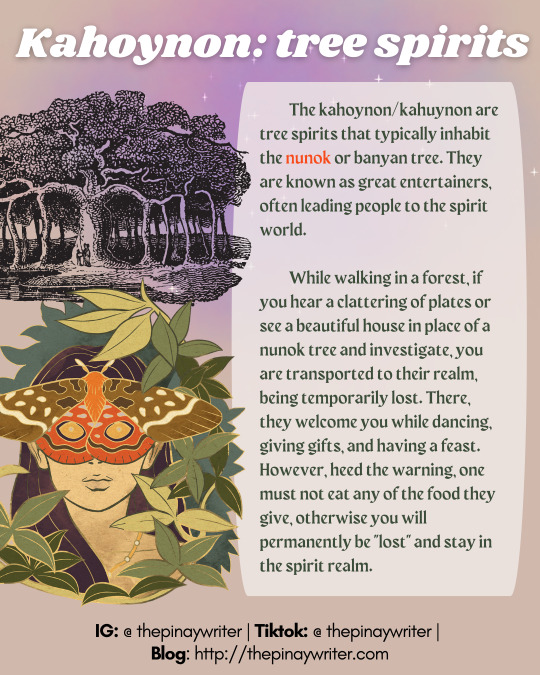

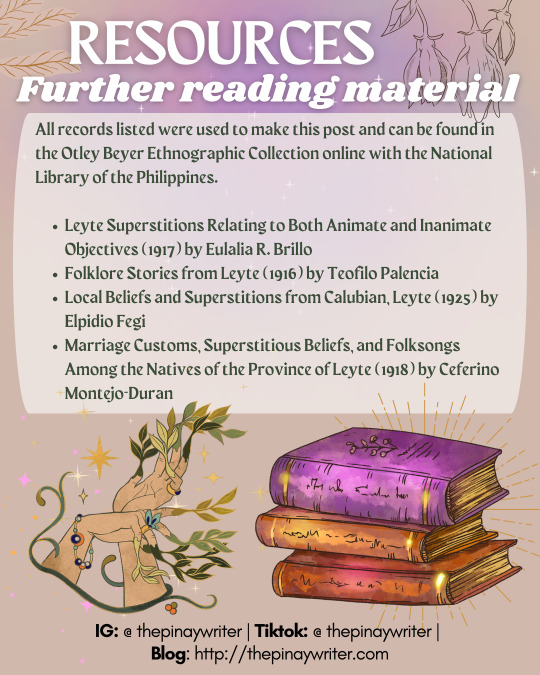
✨️Do you know any of these beliefs and folklore from Leyte? If your family is from Leyte or Samar, what are some folklore, beliefs, and practices that have been shared with you? 🌿
#filipino#philippines#pinoy#filipino mythology#philippine mythology#culture#folklore#mythology#leyte#bisaya#visayan#anito#diwata#precolonial philippines
551 notes
·
View notes
Text
Balahala'ng Kaptan
Balahala'ng Kaptan (The lord Kaptan), is the Visayan's supreme diwata (deity) of the heavens. He is the primordial father of the old pantheon and bears the power of lightning and fire.
More about him on my Patreon!
https://www.patreon.com/posts/hulagway-study-73934126?utm_medium=clipboard_copy&utm_source=copyLink&utm_campaign=postshare_creator

#visayan mythology#mythology#filipino mythology#precolonial philippines#precolonial visayas#kaptan#diwata#devata#balahala#Kaptan#watercolor#watercolor illustration#gods and goddesses#deities#history#filipino culture#filipino history
15 notes
·
View notes
Text

back when I was in my yashahime/inuyasha phase, I started thinking a lot about what a fantasy fairy tale set in precolonial Philippines would look like and ended up with these boars (based on the Visayan warty pig) in the garb of 16th century Visayan royalty, as referenced from the Boxer Codex 🐗
5 notes
·
View notes
Text

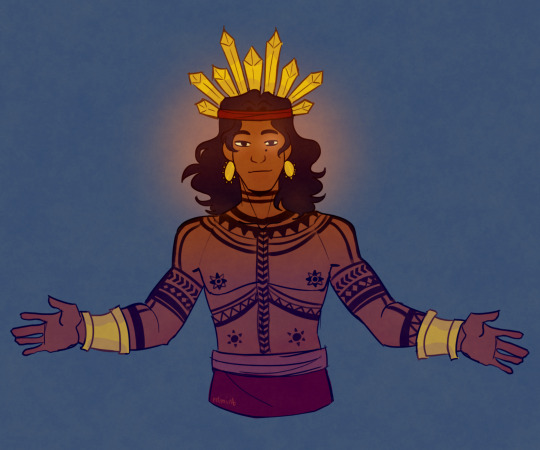
Mayari and Apolaki my beloveds
#philippine mythology#philippines#filipino#SEA#southeast asia#phart#mayari and apolaki#mayari#apolaki#rel'sart#anito#anitu#precolonial philippines#kaluwalhatian#kapampangan
174 notes
·
View notes
Text
He has clothes now
spent a couple of hours gathering filipino traditional full body tattooes
there are a few hidden at his thighs

no i cant draw feet or hands
the tatts aren’t even finished yet but here’s some of the details that got hidden


11 notes
·
View notes